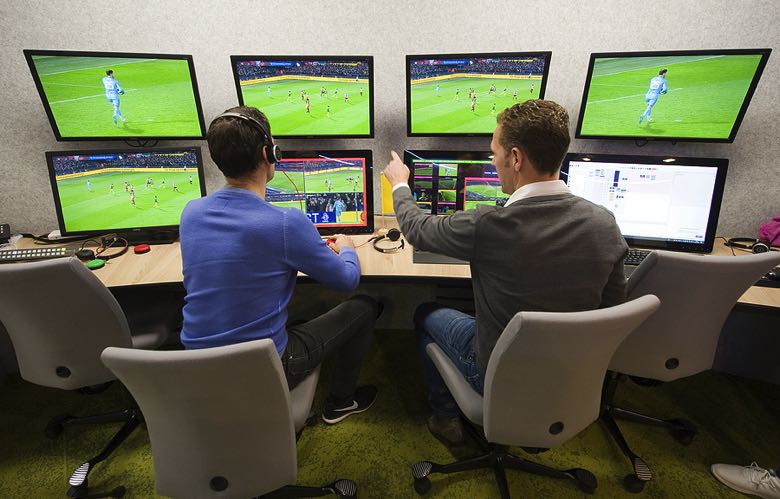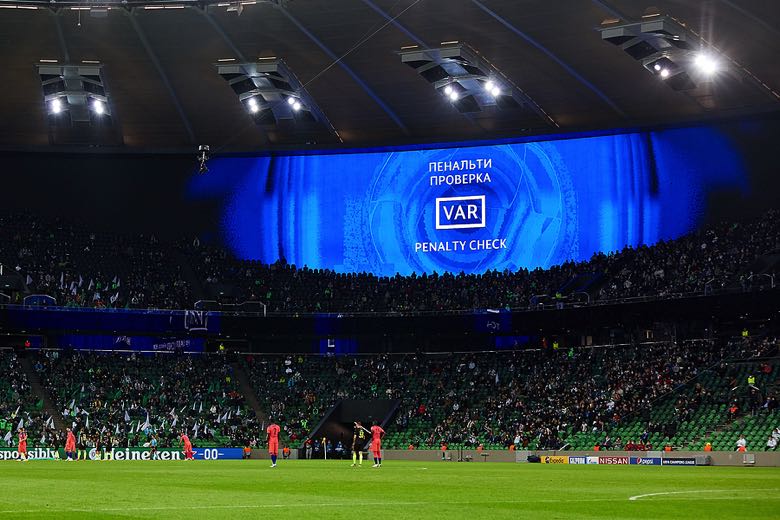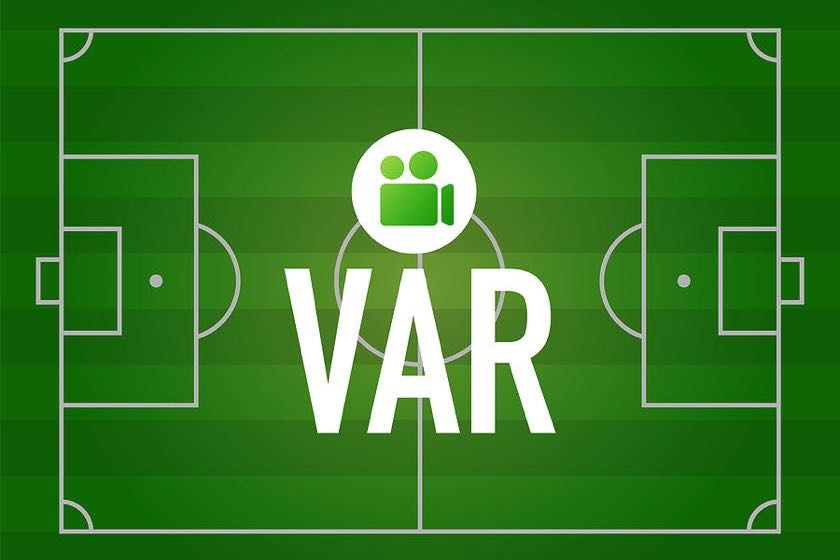VAR, or Video Assistant Referee, is an officiating system that has been added to the game of football to try to ensure that the referees make the right decision in a game. The lightning quick nature of the game is part of what makes it so entertaining and enjoyable.
However, there have already been a huge number of controversies surrounding the use of VAR, with confusion in both the stadium and at home when it is implemented. With technology utilising the huge number of cameras that adorn most major games, why does VAR still seem to get decisions wrong? In this guide to VAR, we will look at what VAR is, how it works, the problems with it and more.
What Is VAR?

VAR is an officiating system that is used in football to help match officials ensure they have made the correct decisions in a game. It will see referee backed up by another official that is not in the ground, with this official able to see all of the available TV angles to ensure that the correct decision is made.
Communicates with Referee
If the VAR official thinks that the referee needs to take a look at an event or decision, then they can speak to the referee via their ear-piece, directing them to watch the event on the monitor on the side of the pitch. This system is also used to ensure that goals that seem on the cusp of not going over the line are correctly given, with the referee’s watch buzzing and telling them if a goal has been scored to ensure no goals are incorrectly ignored.
Three ‘Challenges’
It is similar to the systems that are used in cricket and tennis. In tennis, the players will usually have around three ‘challenges’ that they can make if they disagree with a point or decision. The computerised system will then show the players, match officials and viewers what happened on a particular point. If a player makes a successful challenge, they can then see an incorrect decision overturned.
Only Officiating Team Decides if Review Needed
In cricket, the third umpire will utilise TV replays and alternative camera angles to ensure certain decisions are correct. The on-field umpire can call for a review with regard to run-outs. The system is, like tennis, available to the two teams, with both sides getting a number of reviews they can use if they think a decision is wrong and should be overturned.
The major difference between VAR in football and the review systems in tennis and cricket is that the players and coaches have no power in seeing decisions reviewed in football. Only the officiating team can decide if a review of an event or decision should take place.
The History of VAR
While most laws of the game came into being decades of even centuries ago, any mention of VAR in the Laws of the Game only came in 2018. Despite being around for some time now, VAR was very limited in the ways it could be used until quite recently. VAR was originally trialled in the Eredivisie in the 2012/13 Dutch season.
This would see the Royal Netherlands Football Association (KNVB) petitioning for further tests to be done with VAR. While further improvements took some years to implement, a friendly between Dutch sides PSV and FC Eindhoven was the first match in history to use VAR in the form we see today. This would see multiple other competitions decide to jump on the band wagon by trialling the system. Australia’s A-League became the first top-flight domestic league to adopt VAR in 2017, with Major League Soccer implementing VAR in the second-half of the same season.
With the need for incorrect decisions or events that were missed to be inspected, VAR was written into the Laws of the Game in 2018. At the time, it was heralded as a move that would ensure that the right decision was always made. However, this has been anything but the case.
When Can VAR Be Used in a Game?

This is something that causes a lot of confusion for football fans, with the use of VAR in a match feeling inconsistent. This can be in part down to TV channels and broadcasters not alerting their viewers to a VAR check by either their commentary team mentioning it or there being no on-screen notification.
Similarly, in stadiums across the UK, fans are left completely in the dark at times. This is often because the supporters are not given any notification that there is a VAR check being run, while if they are shown a check is underway on the screens inside the stadium, it will usually only say ‘VAR Check’.
Moves have been made to bring clarity to this situation though, with clear and concise information needed to ensure that the use of VAR is as seamless and effective as possible. VAR can be used in a number of situations, with these including:
Goal/No Goal
A VAR check would begin if:
- A team on the attacking side commits an offence in the build-up to the goal, such as a foul, offside, handball, etc.
- The goalkeeper or penalty taker offend when a penalty is being taken, or an attacking or defending player encroaches on the box
- The ball goes out of play in the build-up to the goal
- Goal/no goal decisions.,
Penalty Decisions
A VAR check would begin if:
- Anyone from the attacking team offends in the build-up to the awarding of the penalty
- To find the exact location of the offence
- A penalty is incorrectly awarded
- A penalty kick offence is not penalised
- The ball goes out of play in the build-up
Red Cards
VAR checks on red cards may begin for:
- The denial of an obvious goal-scoring opportunity
- Reckless challenges or serious foul play
- Biting, spitting or violent conduct
- Abusive or offensive actions
It is important to note that a VAR check is not done for a second yellow card. If a player is shown a straight red card, then a VAR check can proceed, but if a player is shown a second yellow and sent off, a VAR check will not take place.
Mistaken Identity for Red or Yellow Cards
If the referee is to penalise a player and but give a red or yellow card to the wrong player, then VAR can be used to identify the correct player, allowing the officials to rescind the yellow or red card from the wrong player, before then giving it to the right player. It is important to note that VAR cannot be used to review the offence itself in this circumstance.
This would have been particularly important when Arsenal took on Chelsea back in 2014. Alex Oxlade-Chamberlain of the Gunners was able to push Eden Hazard’s shot around the post and should have been shown a red card. However, referee Andre Marriner showed a straight red card to defender Kieran Gibbs instead. The use of VAR in this instance would have seen officials notify the referee that the wrong player had been sent off, with Marriner rescinding the red card that was given to Gibbs, and giving it to Oxlade-Chamberlain instead.
Who Decides When VAR Is Used?

The use of VAR allows a match official, who is usually located outside of the stadium in a van with all available camera angles at their disposal, to assist the match referee if they have made a clear or obvious error or missed some form of major event or incident in the game.
VAR will review action during the game itself, notifying the match referee that they need to view a replay on the pitch side monitor. This monitor will provide the referee with the replays they need to decide for themselves on the best course of action.
While a notification from VAR that the referee needs to watch the replays on the monitor will usually end in a decision being overturned or changed, it is not set in stone that a decision will change. While VAR may suggest a referee has made the wrong decision, upon further inspection, the referee could decide to uphold their original decision even after watching the replays.
It is important to note that players, coaches and fans have no power over when and where VAR is used. The use of VAR itself is not limited during the game, with it available to use as many times as is deemed necessary.
Who Makes the Final Decision after the Review?
The only person that can make a decision following the intervention of VAR is the referee. This means that while VAR may suggest the wrong decision has been made, the referee is free to stand by their own decision if they believe that, in their expert opinion, they are right.
After the process of reviewing the replays is completed, the referee must make the TV signal (where the referee uses their hands to make an imaginary TV screen) before they then make their decision.
Why Do Fans Dislike VAR?
Before we delve into this, it is important to note that not all fans dislike VAR. After all, the inception of the Video Assistant Referee is meant to benefit everyone involved. For the teams, they are less likely to be denied a goal by the ball going over the line but the officials not giving it because it was so close to not going in or because they were unsighted.
In the same way, bad fouls that deserve harsher punishment, fouls that do not deserve a red, offences off the ball and more are all subject to VAR checks. It simply means that any and every event in the game that deserves to be punished will be in the correct way. However, there are a number of reasons why VAR has become an area of anger amongst the fans and players.
Inconsistency
This is a major point of contention among football fans. Many believe that certain fouls in particular are not punished with consistency. They feel that a lunge from one player that is punished by a red card is all too often punished by a yellow card, or nothing at all to another player. This is something that simply should not happen as referees are all given the same information and training, meaning that a foul that is deemed punishable by a red card by one referee should be the same for all other referees.
Of course, human interpretation is always going to see certain decisions viewed in a different way by different people. After all, a football fan on one side may believe a player should have been sent off for a challenge, while another fan would cite it was only a yellow card. This is true of referees. All that VAR has done in this circumstance has given the referees the opportunity to review their decision using all of the available angles that TV viewers have come to expect. While many fans will cite that all they want is consistency, it stands to reason that most supporters will dislike VAR being used if it is of detriment to their team.
Long Delays
There are few more frustrating sites than a pulsating, end-to-end game of football being stopped due to a long VAR check. While the officials try to ensure that any VAR check that is made will only be for an event that absolutely needs to be looked at, the referee viewing the monitor on the side of the pitch can still lead to long delays.
Football has always been a game that is played at a high pace, with this usually resulting in exciting attacking play and goals. The constant delays that VAR checks cause can be very frustrating then, especially with regard to offsides. Usually, an offside call is clear cut, but when it is very tight, officials can take a huge amount of time deciding whether or not a player is onside or offside.
Similarly, many fans have questioned offside decisions made by VAR, with players that seem to be offside called as onside, while some that are in a legal position are seen as being offside. This once again all comes down to consistency.
Players Asking for VAR Checks
A major frustration when it comes to VAR is when players and coaches start calling for a VAR check. You will often see them making the TV signal with their hands, imploring the referee to look at the replays. This is incredibly frustrating as any offence that is deemed worthy of review will be flagged up to the referee by those watching the replays. Usually, if VAR is not employed, it means there is no reason for the referee to look at the replays.
It would not be outside of the realms of possibility that players signalling for a VAR will become a punishable offence, much like players brandishing imaginary cards when they feel a foul is worthy of a yellow or red card.
Is VAR Working?

The simple answer to this question is: yes. VAR gives the referee the ability to go back and check a decision they have made. If the official that is watching the game and using all of those angles deems a situation worthy of review, then they will flag this up to the match referee. This means it is far less likely a major event that is incorrectly ruled upon or missed can be correctly judged.
Similarly, VAR is used to ensure offsides are correctly flagged, while it will tell the referee if the ball has gone over the line, meaning goals will not be missed simply because they were close to not fully going over the line. Where VAR has run into problems is in it’s consistency. Fans question why some decisions are not looked at or why some referees will make different decisions to others despite being able to use VAR.
Again, all the fans are asking for is consistency. However, this is not something that can always be assured as human judgement will differ from official to official. This means that while one person using VAR will think the referee needs to go back to award a penalty, the match official may disagree. Part of what makes football so exciting is the controversy, with fans and pundits always enjoying a good talking point. As long as VAR is assisting human officials, there will always be contention with regard to its use.
Which Major Competitions Use VAR?
There are almost 60 leagues that utilise VAR as of the end of the 2021/22 football season. Major leagues and competitions that use VAR include:
- Premier League
- Serie A
- Bundesliga
- La Liga
- Ligue 1
- FA Cup
- Coppa Italia
- Copa del Rey
- Major League Socer
- Champions League
- Europa League
- World Cup
- European Championships
- Copa America
- African Nations Cup

